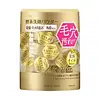What's inside
What's inside
 Key Ingredients
Key Ingredients

 Benefits
Benefits

 Concerns
Concerns

 Ingredients Side-by-side
Ingredients Side-by-side

Talc
AbrasiveMaltitol
HumectantSodium Cocoyl Isethionate
CleansingSodium Myristoyl Glutamate
CleansingSodium Lauroyl Glutamate
Sodium C14-16 Olefin Sulfonate
CleansingPotassium Laurate
EmulsifyingCarrageenan
Glycyrrhiza Glabra Root Extract
BleachingSqualane
EmollientCitric Acid
BufferingSodium Hyaluronate
HumectantHelianthus Annuus Seed Oil
EmollientPersea Gratissima Oil
Skin ConditioningBHT
AntioxidantDipropylene Glycol
HumectantSilk
Ethyl Glucoside
HumectantProtease
ExfoliatingLipase
Skin ConditioningSodium Benzoate
MaskingTalc, Maltitol, Sodium Cocoyl Isethionate, Sodium Myristoyl Glutamate, Sodium Lauroyl Glutamate, Sodium C14-16 Olefin Sulfonate, Potassium Laurate, Carrageenan, Glycyrrhiza Glabra Root Extract, Squalane, Citric Acid, Sodium Hyaluronate, Helianthus Annuus Seed Oil, Persea Gratissima Oil, BHT, Dipropylene Glycol, Silk, Ethyl Glucoside, Protease, Lipase, Sodium Benzoate
Carrageenan
Silk
Methicone
EmollientIsostearyl Alcohol
EmollientBHT
AntioxidantLactic Acid
BufferingSodium Myristoyl Glutamate
CleansingTea-Lauroyl Glutamate
CleansingLipase
Skin ConditioningTalc
AbrasiveProtease
ExfoliatingSodium Cocoyl Isethionate
CleansingSodium Lauroyl Glutamate
Tar Oil
MaskingPotassium Hydroxide
BufferingSodium C14-16 Olefin Sulfonate
CleansingWater
Skin ConditioningPotassium Laurate
EmulsifyingGlyceryl Myristyl Lauroyl Glutamate
HumectantDipropylene Glycol
HumectantLactobacillus
Skin ConditioningPolyquaternium-51
Skin ConditioningButylene Glycol
HumectantAlcohol Denat.
AntimicrobialMethylparaben
PreservativeSodium Laurate
CleansingEthyl Glucoside
HumectantSodium Hyaluronate
HumectantLauryl Laurate
Skin ConditioningPhenoxyethanol
PreservativePotassium Oxide
BufferingBrassica Campestris Extract
Skin ConditioningSodium C14-18 Olefin Sulfonate
CleansingCarrageenan, Silk, Methicone, Isostearyl Alcohol, BHT, Lactic Acid, Sodium Myristoyl Glutamate, Tea-Lauroyl Glutamate, Lipase, Talc, Protease, Sodium Cocoyl Isethionate, Sodium Lauroyl Glutamate, Tar Oil, Potassium Hydroxide, Sodium C14-16 Olefin Sulfonate, Water, Potassium Laurate, Glyceryl Myristyl Lauroyl Glutamate, Dipropylene Glycol, Lactobacillus, Polyquaternium-51, Butylene Glycol, Alcohol Denat., Methylparaben, Sodium Laurate, Ethyl Glucoside, Sodium Hyaluronate, Lauryl Laurate, Phenoxyethanol, Potassium Oxide, Brassica Campestris Extract, Sodium C14-18 Olefin Sulfonate
Ingredients Explained
These ingredients are found in both products.
Ingredients higher up in an ingredient list are typically present in a larger amount.
BHT is a synthetic antioxidant and preservative.
As an antioxidant, it helps your body fight off free-radicals. Free-radicals are molecules that may damage your skin cells.
As a preservative, it is used to stabilize products and prevent them from degrading. Specifically, BHT prevents degradation from oxidation.
The concerns related to BHT come from oral studies; this ingredient is currently allowed for use by both the FDA and EU.
However, it was recently restricted for use in the UK as of April 2024.
Learn more about BHTCarrageenan comes from red seaweed or algae. It is made up of polysaccharides and a highly flexible compound. Red algae cell walls are rich in carrageenan.
In cosmetics, it helps to thicken the texture. Studies show carrageenan extracted from red algae possess antioxidant properties. Components found in carrageenan include: lipids, fatty acids, Vitamin E, proteins, and several amino acids.
Learn more about different types of algae.
Carrageenan is also commonly used in medicine and food. It is a vegan alternative to animal-based gelatin.
Learn more about CarrageenanDipropylene Glycol is a synthetically created humectant, stabilizer, and solvent.
This ingredient helps:
Dipropylene glycol is technically an alcohol, but it belongs to the glycol family (often considered part of the ‘good’ alcohols). This means it is hydrating and gentle on skin unlike drying solvent alcohols like denatured alcohol.
As a masking agent, Dipropylene Glycol can be used to cover the smell of other ingredients. However, it does not have a scent.
Studies show Dipropylene Glycol is considered safe to use in skincare.
Learn more about Dipropylene GlycolWe don't have a description for Ethyl Glucoside yet.
We don't have a description for Lipase yet.
We don't have a description for Potassium Laurate yet.
These enzymes break down protein into smaller peptides and amino acids. They also encourage the formation of new protein.
Our skin uses peptides, amino acids, and protein for maintaining healthy skin cells.
Protease work by breaking peptide bonds in protein with hydrolysis. This is the process of breaking bonds using water.
An in-vitro study (not done on a living organism) found a blend of 3-protease decreases skin inflammation by mitigating the effects of other proteins.
One manufacturer that uses subtilisin, a protease from Bacillus subtilis, claims this ingredient is exfoliating, promotes cell regeneration, and is a good substitute for AHAs. Further research is needed to back up these claims.
Fun fact: The human body contains ~641 protease genes.
Learn more about ProteaseWe don't have a description for Silk yet.
Sodium C14-16 Olefin Sulfonate is a cleansing agent made from a mixture of long chain sulfonate salts. It can also help produce foam.
This ingredient may be drying. We recommend speaking with a professional if you have concerns.
Sodium cocoyl isethionate is a natural ingredient from coconut oil. It is an ultra gentle cleanser that gives a nice foam without drying the skin or impacting the skin barrier.
The amount of foam created depends on the amount of sodium cocoyl isethionate used in the product.
This ingredient also helps improve the spreadability of a product.
Learn more about Sodium Cocoyl IsethionateSodium Hyaluronate is hyaluronic acid's salt form. It is commonly derived from the sodium salt of hyaluronic acid.
Like hyaluronic acid, it is great at holding water and acts as a humectant. This makes it a great skin hydrating ingredient.
Sodium Hyaluronate is naturally occurring in our bodies and is mostly found in eye fluid and joints.
These are some other common types of Hyaluronic Acid:
Learn more about Sodium HyaluronateSodium Lauroyl Glutamate is the sodium salt from the lauric acid of glutamic acid.
It is a surfactant and helps cleanse the skin. Surfactants gather oil, dirt, and other pollutants from your skin so they may be washed away easily.
We don't have a description for Sodium Myristoyl Glutamate yet.
Talc is a clay mineral. It helps absorb moisture and improve the texture of products. Like other types of clay, Talc can have a slight exfoliating effect on skin. Talc can be added to increase the volume of products.
Some Baby powders are made by combining talc with corn starch. The word "talc" comes from Latin and originates from Arabic. Talc is a mineral commonly found throughout the world.
If you have any concerns about using talc, we recommend checking out the FDA's official page.
Learn more about Talc